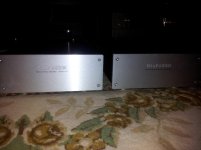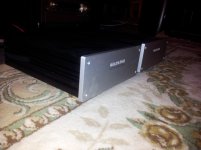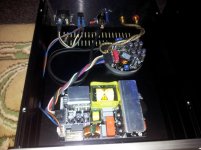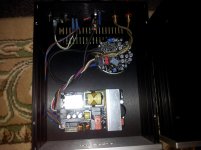Disconnected - but observe electrical safety rules inside your box...
So, it's better to have no "ground" connection to the IEC connector?
So, it's better to have no "ground" connection to the IEC connector?
nc400 datasheet
section 12.3
specifically section 12.3.1
and figure 2
I guess there are tons of apps that can read the .dxf format but I use DraftSight (AutoCAD clone).Can't find it on the Hypex website, could someone point me to it, and what program I would need to open the file on my computer. Do you save it as a PDF, or in pictures. I did try the file posted by mr_push_pull and downloaded WinRAR but I couldn't open the file unless I was doing something wrong. Thanks.
http://dl-ak.solidworks.com/nonsecure/draftsight/V1R3.0/DraftSight32.exe
Last edited:
nc400 datasheet
section 12.3
specifically section 12.3.1
and figure 2
I did use the balanced connection like in figure 2 except for the ground connection, I did actually connect the IEC ground to the chassis.
I don't have ANY hum at all (perhaps due to my source having balanced output transformers), can there be any other sonic improvement if I remove the ground connection to the IEC connector?
from section 12.3.1
"No safety earth connection was depicted. This is entirely acceptable if class II construction is used
throughout. Otherwise, connect the safety earth."
Connecting the mains earth gives an additional noise path - which doesn't mean that there will inherently be noise waiting to go down that path
Noise isn't just mains hum. It's any signal of any form or frequency composition that is not part of the original signal or a distortion within the original signal.
Whether that noise has an audible effect or not on the original signal is another matter. The recommend configuration in the data sheet gives you the best option for overall noise rejection. If you kept with class 2 construction you don't need the mains earth. Removing the earth may have no audible effect in your system.
"No safety earth connection was depicted. This is entirely acceptable if class II construction is used
throughout. Otherwise, connect the safety earth."
Connecting the mains earth gives an additional noise path - which doesn't mean that there will inherently be noise waiting to go down that path
Noise isn't just mains hum. It's any signal of any form or frequency composition that is not part of the original signal or a distortion within the original signal.
Whether that noise has an audible effect or not on the original signal is another matter. The recommend configuration in the data sheet gives you the best option for overall noise rejection. If you kept with class 2 construction you don't need the mains earth. Removing the earth may have no audible effect in your system.
I chose some silver wire that I had laying around for the simple reason that they are NOT flexible and thus would stay put after twisting them. AWG is not that important for the ~10cm length of the wires from the amp to the rear of the cab...... going from the amplifier modules to the speaker binding posts. I understand these wires will be unshielded and are to be twisted, but what type/size (alloy/awg) would be best to use?
Confirmation on input to output gain math
Just wanted to see if some could confirm that if I wanted to increase the gain ratio from input to output, that I should choose a value for RG of under 1.2k.
For instance: a resistor value .800 mf would increase the gain multiplier to 6.5 as opposed to the factory 1.2k mf giving a gain multiplier of 4.67.
I'm basing the total gain off of: 4.17(1+2*RF/RG) for a 1V input.
I really need to raise the input gain so I can attenuate the output of my Phasure NOS1 more to lower the DC offset and keep the NCores from going into protect without adding coupling caps.
Thanks for anyone's help,
Todd
Just wanted to see if some could confirm that if I wanted to increase the gain ratio from input to output, that I should choose a value for RG of under 1.2k.
For instance: a resistor value .800 mf would increase the gain multiplier to 6.5 as opposed to the factory 1.2k mf giving a gain multiplier of 4.67.
I'm basing the total gain off of: 4.17(1+2*RF/RG) for a 1V input.
I really need to raise the input gain so I can attenuate the output of my Phasure NOS1 more to lower the DC offset and keep the NCores from going into protect without adding coupling caps.
Thanks for anyone's help,
Todd
Can I just confirm that when I have finished building the amps, I measure across the +/- of the speaker posts for 0 mV, and only have to adjust R95/R136 if it’s off. Thanks.
Yes wait until they have settled for a few minutes and Nampon grounded then test - within +/- 10mv is perfect.
I'm not an expert, but woudn't adding a couple of high quality couple caps be much easier and flexible? what's the problem with couple caps?I really need to raise the input gain so I can attenuate the output of my Phasure NOS1 more to lower the DC offset and keep the NCores from going into protect without adding coupling caps.
Lowering NC400 output gain
I tried 4 high grade Mundorf caps(balanced inputs). Unfortunately, the NOS1 is so resolving, the caps had a negative effect on the resolution. It certainly sounded better without them. I'm just not able to listen at a volume that I'd like to. Decreasing the digital attenuation(raising the output) on the NOS1 beyond a certain amount increases the DC enough to throw the NC400s into protect.
And adding a preamp is not an option as it also negatively effects the resolution. It seems like lowering the resistance on resistor 141(RG) would have less impact on the system's resolution, but I've only seen examples of NC400s lowering the amplifier gain by removing R141.
Quote:
Originally Posted by Turbonsx
I really need to raise the input gain so I can attenuate the output of my Phasure NOS1 more to lower the DC offset and keep the NCores from going into protect without adding coupling caps.
I'm not an expert, but woudn't adding a couple of high quality couple caps be much easier and flexible? what's the problem with couple caps?
I tried 4 high grade Mundorf caps(balanced inputs). Unfortunately, the NOS1 is so resolving, the caps had a negative effect on the resolution. It certainly sounded better without them. I'm just not able to listen at a volume that I'd like to. Decreasing the digital attenuation(raising the output) on the NOS1 beyond a certain amount increases the DC enough to throw the NC400s into protect.
And adding a preamp is not an option as it also negatively effects the resolution. It seems like lowering the resistance on resistor 141(RG) would have less impact on the system's resolution, but I've only seen examples of NC400s lowering the amplifier gain by removing R141.
I really need to raise the input gain so I can attenuate the output of my Phasure NOS1 more to lower the DC offset and keep the NCores from going into protect without adding coupling caps.
The gain of the nCore (or rather input sensitivity) is already pretty high - several of us have had to lower the gain. While Bruno & co have commented on lowering the gain, I am not sure what the effects of increasing the gain will be - decreasing feedback? Increased instability? Definitely increased sensitivity to noise.
The problem is the DC offset from the NOS1 - you should deal with that problem, and not try to band-aid over it by increasing the nCore gain. A DAC with significant DC offset is badly designed.
Also be aware of the fact that the NOS1 can have a significant amount of unfiltered HF noise on the output - it might cause intermodulation in the amplifier.
Thanks for the reply Julf,
The DC on the NOS1 is do to the Phase Alignment feature of the XXHighend software. The DC offset is quite low without this feature engaged and plays fine at all volumes. I just like the effect the phase alignment feature has on improving the realism of bass instruments and soundstage.
I'll play around some more with the coupling caps. I certainly don't want to do anything that affects the additional focus and clarity that the NC400s provide.
Remember I'm not trying to increase the gain of the NC400, just to change the differential buffer stage sensitivity to increase the gain relative to a given input voltage. I'm really looking to gain about 6-9db of of input sensitivity and the slight decrease in signal to noise might be worth the trade off instead adding coupling caps, not to mention the $'s
Todd
The DC on the NOS1 is do to the Phase Alignment feature of the XXHighend software. The DC offset is quite low without this feature engaged and plays fine at all volumes. I just like the effect the phase alignment feature has on improving the realism of bass instruments and soundstage.
I'll play around some more with the coupling caps. I certainly don't want to do anything that affects the additional focus and clarity that the NC400s provide.
Remember I'm not trying to increase the gain of the NC400, just to change the differential buffer stage sensitivity to increase the gain relative to a given input voltage. I'm really looking to gain about 6-9db of of input sensitivity and the slight decrease in signal to noise might be worth the trade off instead adding coupling caps, not to mention the $'s
Todd
Barrows,
Just the M-cap supremes, 1 mf. I didn't want to outlay to much money initially.
The NCore's are only running the mid/high. The bass and sub- bass are handled through separate amps running through an active x-over that is Jensen transformer coupled, so no DC issues on those.
The Jensen coupling on the mid/high drivers was killing the resolution of the NOs1' so I'm running them straight from the NC400's with a passive x-over between the mid/tweeter and no x-over on the bottom end of the mids.
I should mention these are Audio Artistry Beethoven Grandes, so full dipoles on all drivers.(Premier design of Linkwitz before he left the company and started doing the DIY Orion's.)
Todd
Just the M-cap supremes, 1 mf. I didn't want to outlay to much money initially.
The NCore's are only running the mid/high. The bass and sub- bass are handled through separate amps running through an active x-over that is Jensen transformer coupled, so no DC issues on those.
The Jensen coupling on the mid/high drivers was killing the resolution of the NOs1' so I'm running them straight from the NC400's with a passive x-over between the mid/tweeter and no x-over on the bottom end of the mids.
I should mention these are Audio Artistry Beethoven Grandes, so full dipoles on all drivers.(Premier design of Linkwitz before he left the company and started doing the DIY Orion's.)
Todd
Todd,
Yes, I understand the DC offset comes from the "magic" Phase Alignment feature, but I still view it as a design problem - it should not be too hard to do the required processing while maintaining (or restoring) the DC balance.
A pair of smallish high-quality caps should not have a major impact on the sound quality.
i am not sure I understand the distinction. 6-9db of increase in input sensitivity (and thus gain) will result in a corresponding loss in signal-to-noise.
The DC on the NOS1 is do to the Phase Alignment feature of the XXHighend software. The DC offset is quite low without this feature engaged and plays fine at all volumes. I just like the effect the phase alignment feature has on improving the realism of bass instruments and soundstage.
Yes, I understand the DC offset comes from the "magic" Phase Alignment feature, but I still view it as a design problem - it should not be too hard to do the required processing while maintaining (or restoring) the DC balance.
I'll play around some more with the coupling caps. I certainly don't want to do anything that affects the additional focus and clarity that the NC400s provide.
A pair of smallish high-quality caps should not have a major impact on the sound quality.
Remember I'm not trying to increase the gain of the NC400, just to change the differential buffer stage sensitivity to increase the gain relative to a given input voltage
i am not sure I understand the distinction. 6-9db of increase in input sensitivity (and thus gain) will result in a corresponding loss in signal-to-noise.
- Status
- Not open for further replies.
- Home
- Amplifiers
- Class D
- Hypex Ncore



